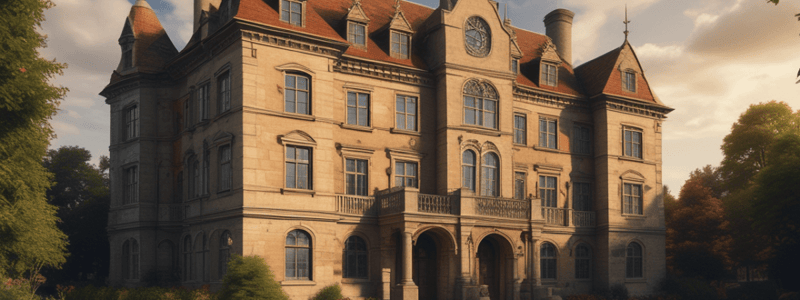Podcast
Questions and Answers
What was the name for exceptionally large estates in the south of Spain and Spanish colonies?
What was the name for exceptionally large estates in the south of Spain and Spanish colonies?
- Estate
- Castle
- Hacienda (correct)
- Manor
Which structure was the center of communal life on a manor?
Which structure was the center of communal life on a manor?
- Buttery
- Great Hall (correct)
- Kitchen
- Solar
What was the official religion across most of Europe during the medieval period?
What was the official religion across most of Europe during the medieval period?
- Protestantism
- Islam
- Roman Catholicism (correct)
- Orthodox Christianity
Which part of a manor house was the private quarters of the lord and his family?
Which part of a manor house was the private quarters of the lord and his family?
How were most manor houses fortified for defense?
How were most manor houses fortified for defense?
Flashcards are hidden until you start studying
Study Notes
What is a Manor?
- A manor is a piece of land granted to a lord by the king during the Middle Ages in Europe.
- A manor house is the large, central structure of the manor, usually serving as the home of the lord.
Manor Life
- Peasants made up nearly 75% of the population in medieval Europe and were almost entirely dependent upon their lords for both protection and the right to use manorial lands for their own sustenance.
- Typically, peasants worked six days a week, spending two to three days working on the demesne, and the rest of the days tending to their own land.
- The typical peasant diet consisted mainly of cereals such as barley and wheat, which they would make into bread and porridge.
Manor Structure
- A manor house usually included a Great Hall, kitchen, buttery, food storage area, and the solar, which was the private quarters of the lord and his family.
- Before the usage of glass, window openings were typically very small and covered with wooden shutters.
Lords in Medieval Times
- Lords were members of the noble class that were granted possession and use of land from the king.
- In return, lords paid homage to the king and swore to protect the land from outside invaders.
Manor Middle Ages History
- Manors and manor houses could be found in several countries across Europe, including England, France, Spain, and the Netherlands.
- The wealthiest and more powerful nobles also built castles, from which they could manage and protect multiple manors.
Difference between a Manor and a Castle
- Castles were very large and heavily fortified with features such as towers, battlements, and high walls.
- Manors were smaller, built more for comfort and domestic use, with some defensive fortifications such as protective walls and moats.
Examples of Manor Houses Across Europe
- English Manors: Typically, early English manors were fortified for protection, but later, building styles tended to be more about demonstrating status and position in the social hierarchy.
- French Manors: Medieval manor houses, called chateaus or manoirs, were heavily fortified, especially during the Hundred Years' War.
- Spanish Manors: Manor houses, or casa solariega, were called by different names depending on the geographic location, size of the manor, or the social ranking of the family that owned it.
- Dutch Manors: Manors, or heerlijkheden, were part of medieval life in the Netherlands under the feudal system, and later, newly wealthy merchants purchased manors and estates.
Studying That Suits You
Use AI to generate personalized quizzes and flashcards to suit your learning preferences.




